初中英语语法专题(状语从句)讲解
- 格式:doc
- 大小:57.00 KB
- 文档页数:5

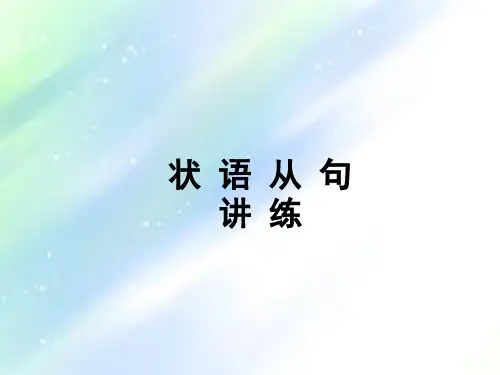
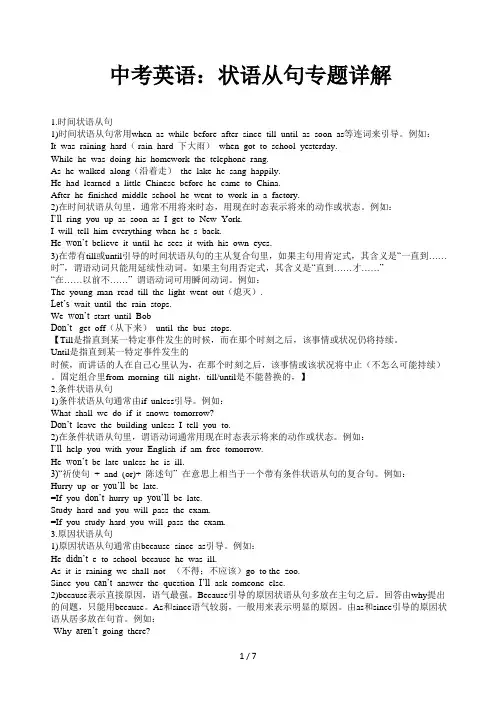
中考英语:状语从句专题详解1.时间状语从句1)时间状语从句常用when as while before after since till until as soon as等连词来引导。
例如:It was raining hard( rain hard 下大雨)when got to school yesterday.While he was doing his homework the telephone rang.As he walked along(沿着走)the lake he sang happily.He had learned a little Chinese before he came to China.After he finished middle school he went to work in a factory.2)在时间状语从句里,通常不用将来时态,用现在时态表示将来的动作或状态。
例如:I’ll ring you up as soon as I get to New York.I will tell him everything when he s back.He won’t believe it until he sees it with his own eyes.3)在带有till或until引导的时间状语从句的主从复合句里,如果主句用肯定式,其含义是“一直到……时”,谓语动词只能用延续性动词。
如果主句用否定式,其含义是“直到……才……”“在……以前不……”谓语动词可用瞬间动词。
例如:The young man read till the light went out(熄灭).Let’s wait until the rain stops.We won’t start until BobDon’t get off(从下来)until the bus stops.【Till是指直到某一特定事件发生的时候,而在那个时刻之后,该事情或状况仍将持续。


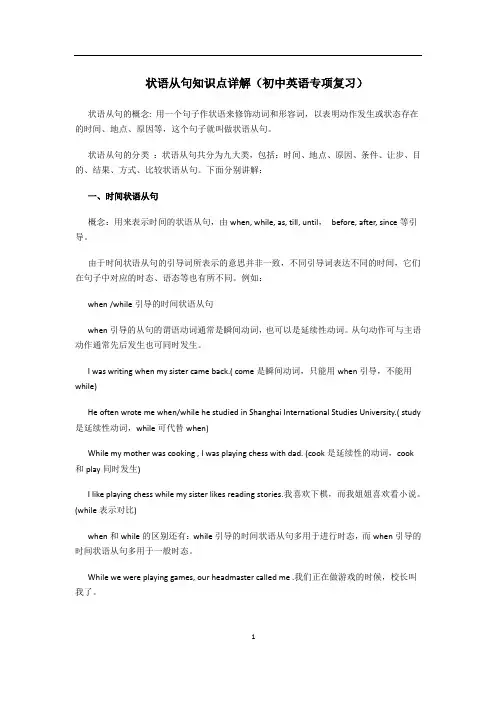
状语从句知识点详解(初中英语专项复习)状语从句的概念: 用一个句子作状语来修饰动词和形容词,以表明动作发生或状态存在的时间、地点、原因等,这个句子就叫做状语从句。
状语从句的分类:状语从句共分为九大类,包括:时间、地点、原因、条件、让步、目的、结果、方式、比较状语从句。
下面分别讲解:一、时间状语从句概念:用来表示时间的状语从句,由when, while, as, till, until,before, after, since等引导。
由于时间状语从句的引导词所表示的意思并非一致,不同引导词表达不同的时间,它们在句子中对应的时态、语态等也有所不同。
例如:when /while引导的时间状语从句when引导的从句的谓语动词通常是瞬间动词,也可以是延续性动词。
从句动作可与主语动作通常先后发生也可同时发生。
I was writing when my sister came back.( come是瞬间动词,只能用when引导,不能用while)He often wrote me when/while he studied in Shanghai International Studies University.( study 是延续性动词,while可代替when)While my mother was cooking , I was playing chess with dad. (cook是延续性的动词,cook和play同时发生)I like playing chess while my sister likes reading stories.我喜欢下棋,而我姐姐喜欢看小说。
(while表示对比)when和while的区别还有:while引导的时间状语从句多用于进行时态,而when引导的时间状语从句多用于一般时态。
While we were playing games, our headmaster called me .我们正在做游戏的时候,校长叫我了。
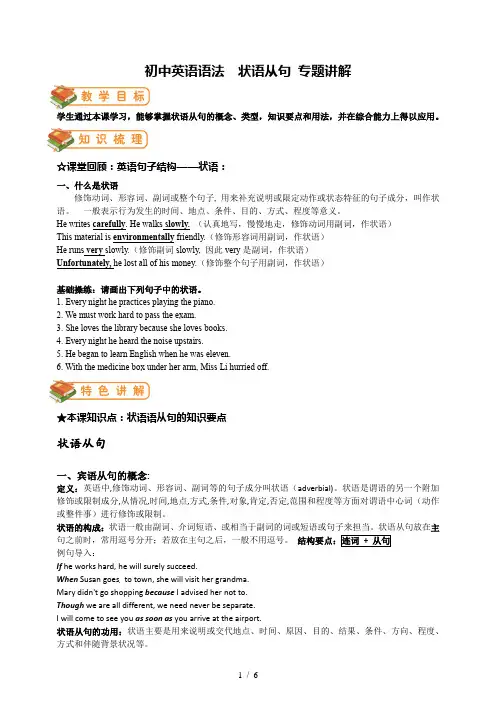
初中英语语法状语从句专题讲解学生通过本课学习,能够掌握状语从句的概念、类型,知识要点和用法,并在综合能力上得以应用。
☆课堂回顾:英语句子结构——状语:一、什么是状语修饰动词、形容词、副词或整个句子, 用来补充说明或限定动作或状态特征的句子成分,叫作状语。
一般表示行为发生的时间、地点、条件、目的、方式、程度等意义。
He writes carefully. He walks slowly.(认真地写,慢慢地走,修饰动词用副词,作状语)This material is environmentally friendly.(修饰形容词用副词,作状语)He runs very slowly.(修饰副词slowly, 因此very是副词,作状语)Unfortunately, he lost all of his money.(修饰整个句子用副词,作状语)基础操练:请画出下列句子中的状语。
1. Every night he practices playing the piano.2. We must work hard to pass the exam.3. She loves the library because she loves books.4. Every night he heard the noise upstairs.5. He began to learn English when he was eleven.6. With the medicine box under her arm, Miss Li hurried off.★本课知识点:状语语从句的知识要点状语从句一、宾语从句的概念:定义:英语中,修饰动词、形容词、副词等的句子成分叫状语(adverbial)。
状语是谓语的另一个附加修饰或限制成分,从情况,时间,地点,方式,条件,对象,肯定,否定,范围和程度等方面对谓语中心词(动作或整件事)进行修饰或限制。
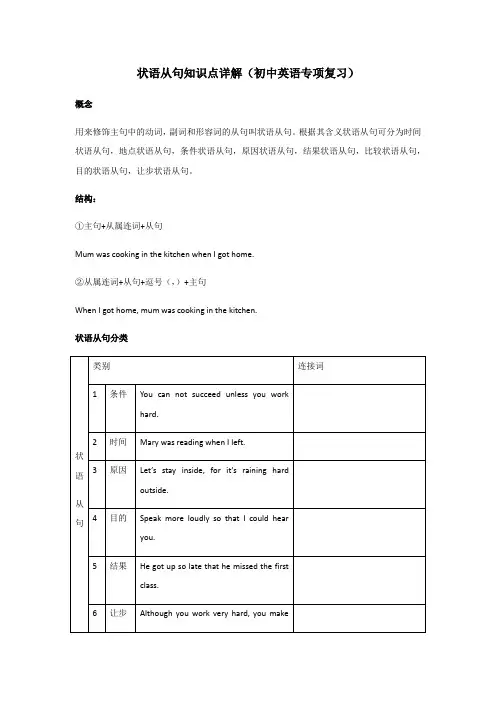
状语从句知识点详解(初中英语专项复习)概念用来修饰主句中的动词,副词和形容词的从句叫状语从句。
根据其含义状语从句可分为时间状语从句,地点状语从句,条件状语从句,原因状语从句,结果状语从句,比较状语从句,目的状语从句,让步状语从句。
结构:①主句+从属连词+从句Mum was cooking in the kitchen when I got home.②从属连词+从句+逗号(,)+主句When I got home, mum was cooking in the kitchen.状语从句分类时间状语从句条件状语从句常见句型转换题:If...not = unless,在句型转换题中,if (如果)常常和unless(除非)and(那么)或or(否则)互换。
If you don’t get up early, you will fail to catch the bus.(保持句意不变)= You won’t catch the bus unless you get up early.=You should get up early, or you will miss the bus.=Get up early, and you may/ will catch the bus.原因状语从句because 和so 不能用于同一句子中,because表示原因未知,语气最强回答why的提问。
because引导的从句可与because of引导的简单句互换。
as 语气最弱,常常用于口语中,since和nowthat(既然)表示已知的原因,一般放在主句之前。
She didn’t go to see the movie because the weather was bad.=She didn’t go to see the movie because of the bad weather.The sports meeting was put off because the weather was bad.=The sports meeting was put off because of the bad weather.目的状语从句so that +从句=in order that+从句常与in order to 和so as to +短语互换,目的状语从句常常会和情态动词can, may, will, could, might, would等连用He walked quickly so that he could get there on time.=He walked quickly in order that he could get there on time.=He walked quickly in order to get there on time.=He walked quickly so as to get there on time.结果状语从句So...that(如此.......以至于)在句型转换中常常会和enough to do 或者too...to互换,结果状语状语从句常常会和情态动词can, may, will, could, might, would等连用。
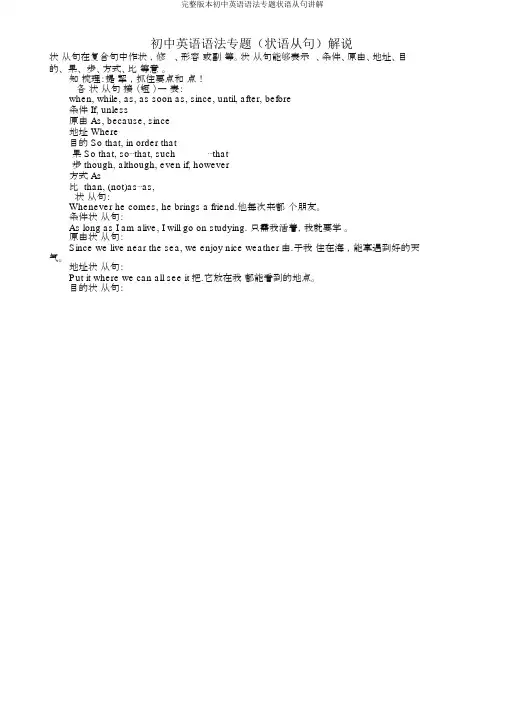
初中英语语法专题(状语从句)解说状从句在复合句中作状,修、形容或副等。
状从句能够表示、条件、原由、地址、目的、果、步、方式、比等意。
知梳理:提挈,抓住要点和点!各状从句接(短)一表:when, while, as, as soon as, since, until, after, before条件 If, unless原由 As, because, since地址 Where目的 So that, in order that果 So that, so⋯that, such⋯that步 though, although, even if, however方式 As比 than, (not)as⋯as,状从句:Whenever he comes, he brings a friend.他每次来都个朋友。
条件状从句:As long as I am alive, I will go on studying. 只需我活着,我就要学。
原由状从句:Since we live near the sea, we enjoy nice weather由.于我住在海,能享遇到好的天气。
地址状从句:Put it where we can all see it把.它放在我都能看到的地点。
目的状从句:Finish this so that you can start another把.个做完,你能够开始另一个。
果状从句:He was so angry that he couldn't say a word.他气得不出了。
步状从句:Though he is in poor health, he works hard. 然他身体不好,可是他工作很努力。
方式状从句:Students do as the teachers say学.生依据老的去做。
比状从句:The work isn't as easy as I thought. 工作比我想象得。

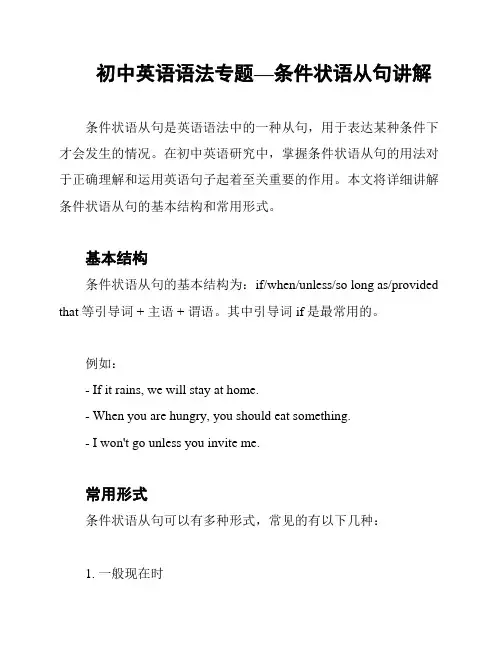
初中英语语法专题—条件状语从句讲解条件状语从句是英语语法中的一种从句,用于表达某种条件下才会发生的情况。
在初中英语研究中,掌握条件状语从句的用法对于正确理解和运用英语句子起着至关重要的作用。
本文将详细讲解条件状语从句的基本结构和常用形式。
基本结构条件状语从句的基本结构为:if/when/unless/so long as/provided that等引导词 + 主语 + 谓语。
其中引导词if是最常用的。
例如:- If it rains, we will stay at home.- When you are hungry, you should eat something.- I won't go unless you invite me.常用形式条件状语从句可以有多种形式,常见的有以下几种:1. 一般现在时如果主句是一般将来时,条件从句常用一般现在时表示将来的条件。
例如:2. 一般过去时如果主句是过去时,条件从句常用一般过去时表示过去的条件。
例如:- If it rained, we stayed at home.3. were to + V原用于表达与现在事实相反的情况,表示假设的内容。
例如:- If I were rich, I would buy a big house.4. should + V原表示建议或者要求。
例如:- If you should have any problems, feel free to ask for help.5. 省略 if在主句前可以省略if,但主句表达的语气必须是祈使句。
例如:- Study hard, and you will succeed.高级用法除了以上的基本结构和常用形式,条件状语从句还有一些高级用法需要注意。
1. 虚拟条件句表示与现在事实相反的假设情况,常用虚拟语气来表示。
例如:- If I won the lottery, I would travel around the world.2. 祈使句当主句为祈使句时,条件状语从句常用完全倒装的形式。
初中英语语法学习之状语从句精讲英语状语从句是英语学习中的一个重要考点,下面将针对英语状语从句进行考点归纳。
一、时间状语从句时间状语从句是语法中的一个重要考点,下面是一些常见的时间状语从句:when:表示某个时间点或时间段,如“I will arrive at the airport when the plane takes off.”before:表示某个时间点或时间段之前,如“I will eat breakfast before I go to work.”after:表示某个时间点或时间段之后,如“I will finish my homework after I have dinner.”while:表示某个时间点或时间段持续,如“I was studying while she was sleeping.”as soon as:表示某个时间点或时间段一过去就发生,如“I will call you as soon as I get home.”until:表示某个时间点或时间段一直持续,如“I won't leave until I have finished my work.”since:表示某个时间点或时间段以来,如“I have been living in this city since I moved here last year.”when/while/as:这些词都可以引导时间状语从句,但它们的使用略有不同,需要根据具体语境选择使用哪个。
需要注意的是,如果主句是一般将来时,从句只能用一般现在时,如“I will go to the store tomorrow”中的“tomorrow”就是时间状语从句。
二、地点状语从句地点状语从句是语法中的一个重要考点,下面是一些常见的地点状语从句: where:表示某个地点,如“I will go to the store where I bought the groceries.”that:表示某个地点或位置,如“I saw a beautiful sunset over that mountain.”which:表示某个地点或位置,如“The building which is on fire needs to be evacuated immediately.”where/that/which:这些词都可以引导地点状语从句,但它们的使用略有不同,需要根据具体语境选择使用哪个。
一,状语从句状语从句在主从复合句中修饰主句中的动词、形容词或副词等,起副词的作用。
状语从句由从属连词引导,从属连词在从句中不担任任何句子成分。
状语从句可位于主句之前,也可位于主句之后。
位于主句之前,一般要加逗号与主句分开;位于句末则不需要。
状语从句根据它所表达的意思可分为时间、地点、原因、目的、结果、比较,让步、方式和条件状语从句等类。
(一),时间状语从句引导时间状语从句的从属连词有:when, while, as soon as, before, after, since , till, until 等【注】1,until (till) 直到,在用until 表达时间状语的句子中,主句中的动词是要十分小心去选择。
如动词是持续性动词,它要用肯定句,如:I studied hard until 12 o'clock last night. 如果动词是瞬间截止性动词,则要用否定句,即,not---until “直到…才”。
如:He didn't go to bed until his mother came back.They didn’t stop until they finished t he work .2,时间状语从句中的谓语动词不能用,将来时,终能用一般现在时表示一般将来时,即“主将从现”原则。
如,When he comes, I’ll tell him about it.I will call you as soon as I arrive in Beijing. 我到北京就将给你打电话(二),条件状语从句通常由从属连词if,unless等引导【注】1,条件状语从句与时间状语从句一样,从句中不能用将来时态,要用一般现在时态表示一般将来时态,也符合“主将从现”原则。
如,If it snows tomorrow, we will build a snowman.If it rains, they won't go to the park on SundayI won’t go to his party unless I am invited .,2,要区别是条件、时间状语从句还是宾语从句,因为在宾语从句中该用什么时态用什么时态,如:I want to know if he will come here tomorrowI want to know if it will rain tomorrow. If it doesn’t rain, I will go hiking.I don’t know when he will come, When he comes, I’ll tell him about it.(三),让步状语从句通常由从属连词though(although)(虽然,尽管),even if(even though)(即使)等引导注:翻译是后半句带有转折的意味,但不能由but连接。
初中英语语法知识状语从句课件一、教学内容本节课我们将学习人教版初中英语教材中第七章“状语从句”的相关内容。
具体包括状语从句的定义、分类以及各类状语从句的用法。
详细内容如下:1. 状语从句的定义及作用;2. 时间状语从句的用法,如:when, while, as, after, before, since, until等;3. 地点状语从句的用法,如:where, wherever等;4. 原因状语从句的用法,如:because, since, as, why等;5. 目的状语从句的用法,如:so that, in order that等;6. 结果状语从句的用法,如:sothat, suchthat等;7. 条件状语从句的用法,如:if, unless, as/so long as等;8. 比较状语从句的用法,如:than, asas等。
二、教学目标1. 理解并掌握状语从句的定义、分类及各类状语从句的用法;2. 能够正确运用各类状语从句进行句子构建,提高英语表达能力;3. 通过实践练习,培养学生在实际语境中运用状语从句的能力。
三、教学难点与重点重点:各类状语从句的用法及其在句子中的作用。
难点:如何在实际语境中灵活运用各类状语从句。
四、教具与学具准备1. 教师准备:多媒体课件、黑板、粉笔;2. 学生准备:课本、笔记本、练习本。
五、教学过程1. 导入:通过一个实践情景引入,让学生了解状语从句在句子中的作用,激发学习兴趣;2. 讲解:详细讲解各类状语从句的用法,配合例句和实际语境,让学生更好地理解和掌握;3. 练习:设计随堂练习,让学生运用所学知识进行句子构建,巩固所学内容;4. 互动:组织学生进行小组讨论,互相交流学习心得,提高课堂氛围;6. 作业布置:布置课后作业,让学生进一步巩固所学知识。
六、板书设计1. 初中英语语法知识——状语从句;2. 内容:状语从句的定义、分类、各类状语从句的用法;3. 例句:各类状语从句的典型例句;4. 练习:随堂练习题目。
初中英语语法专题(状语从句)讲解
状语从句在复合句中作状语,修饰动词、形容词或副词等。
状语从句可以表示时间、条件、原因、地点、目的、结果、让步、方式、比较等意义。
知识梳理:提纲挈领,抓住重点和难点!
各类状语从句连接词(短语)一览表:
时间 when, while, as, as soon as, since, until, after, before
条件 If, unless
原因 As, because, since
地点 Where
目的 So that, in order that
结果So that, so…that, such…that
让步 though, although, even if, however
方式 As
比较 t han, (not)as…as,
时间状语从句:
Whenever he comes, he brings a friend. 他每次来都带个朋友。
条件状语从句:
As long as I am alive, I will go on studying. 只要我活着,我就要学习。
原因状语从句:
Since we live near the sea, we enjoy nice weather.由于我们住在海边,能享受到好的天气。
地点状语从句:
Put it where we can all see it.把它放在我们都能看到的位置。
目的状语从句:
Finish this so that you can start another.把这个做完,你可以开始另一个。
结果状语从句:
He was so angry that he couldn't say a word. 他气得说不出话了。
让步状语从句:
Though he is in poor health, he works hard.虽然他身体不好,但是他工作很努力。
方式状语从句:
Students do as the teachers say.学生们按照老师说的去做。
比较状语从句:
The work isn't as easy as I thought.这项工作比我想象得难。
例题解析:举一反三,学的更轻松!
1. 易混引导词while, when, as的区别:
when既可以指"时间点",与瞬间动词连用,也可以指"时间段",与延续性动词连用
(=while)。
如:
When he came in, his mother was cooking.
When (While) we were at school, we went to the library every day.
While表示时间段,因此,while 从句的谓语动词要用延续性动词。
如:
Please don't talk so loud while others are working.
As与when用法相似,但着重强调主句动作与从句动作同时发生,有"随着……"或"一边……一边……"之意。
如:
As you get older, you get more knowledge.随着年龄的增长,你获得的知识就越多。
2.Because,as,since 的区别:
Because用于表示直接原因,回答why提出的问题,语气最强;As用于说明原因, 着重点在主句,常译成"由于";since表示显然的或已知的理由或事实,常译成"既然"。
如:
Water is very important because we can't live without it.
He didn't come yesterday as his mother was ill.
I'll do it for you since you are busy.
3.such…that, so…that, so that 引导结果状语从句的区别:
such是形容词,修饰名词; so 是副词,修饰形容词或副词。
其结构如下:
1) such + a (n)+ 形容词+单数可数名词+that……
2) such+形容词+复数可数名词+that ……
3) such +形容词+不可数名词+that……。
如:
This was such a good film that I went to see it several times.
It was such good books that they sell well.
It was such bad weather that I had to stay at home.
He spoke so fast that I couldn't follow him.
He is such a lovely boy that we all like him.
=He is so lovely a boy that we all like him.
注:在"形容词+可数名词复数/不可数名词"结构中,当名词前有many, much, few, little 表示数量的多少时,名词前用so。
如:
She made so many mistakes that she didn't pass the exam.
练习与巩固:熟能生巧,取得好成绩!
选择合适的连接词,完成下列句子。
1.Jim spends a lot of money on books______he is not rich.
2.Kate fell into sleep ______she was listening to the music.
3.----Is David at school today?
----No. He is at home ______he has a bad cold.
4.We won't have supper ______my mother comes back.
5.Speak to him slowly ______he may understand you better.
6. ______ she doesn't come on Sunday, I'll go fishing by myself.
7.It is four years ______I had left that small village.
8. ______the air moves, it is called wind.
9.We will go to the park ______it doesn't rain tomorrow.
10.______little boys did ______much work.
11.There are few new words in the passage ______we can't understand it.
12.Go back ______you come from.
13.He reached the station ______the train had left.
14.----Do you have a swimming pool?
----No, we don't. At least, not ______big ______yours.
15.Give me your paper ______you have finished it.
16.It is raining hard, ______we have to stay at home.
17. ______you work harder, you'll never pass the final exam.
18.Look after the children ______I am out.
19.The village is ______far away ______I can't get there on foot.
20.That is ______an interesting book ______I can't stop reading it. Keys: 1.though 2.while 3.because 4.until 5. so that
6.Even if
7.since
8.when
9.if 10.Such, do
11.but 12.where 13.before 14.as(so), as 15.after
16.so 17.unless 18.while 19.so, that 20.such, that
珠海新思维教育科技有限公司
5
忘记你,我做不到!。